Measuring CO2 Concentration and Thermal Comfort in Italian University Classrooms: A Seasonal Analysis
Abstract
1. Introduction
2. Materials and Methods
2.1. Experimental Setup
2.2. Experimental Protocol
- Ventilation system—Natural ventilation through windows;
- Windows—B1 and F8 are equipped with 4 single-glazed aluminum inward-opening windows; whereas F9 with 2 single-glazed aluminum inward-opening windows.
- Equipment—Desks, chairs, projector, whiteboard;
- Heating system—Central heating with radiators along walls;
- Location and orientation: low-traffic area surrounded by open fields and east-to-northeast orientation; the direct sunlight exposure is primarily limited to the morning hours.
- Height: Sensors were installed at approximately 1.5 m above the floor, which corresponds to the breathing zone of seated occupants. This placement minimized measurement bias from non-representative air strata.
- Distance from Occupants: Sensors were placed 1.5–2 m away from occupants to reduce direct interference from exhaled air.
- Distance from Obstacles: A minimum distance of 1 m was maintained from walls, bookshelves, and other potential obstructions to ensure an unobstructed measurement of the indoor air.
- Ventilation Interference: Sensors were positioned away from direct airflow caused by windows, doors, or air conditioning units to avoid artificial fluctuations in readings.
- Heat Sources: Care was taken to avoid proximity to radiators, spotlights, or other heat sources that could influence temperature and relative humidity measurements.
2.3. Data Analysis
2.4. Statistical Analysis
3. Results and Discussions
3.1. Temperature, Relative Humidity and CO2 Concentration: Seasoning Variations and Correlation
3.2. Thermal Comfort Analysis
3.3. Policy Implications and Recommendations
3.4. Limitations
4. Conclusions
Author Contributions
Funding
Institutional Review Board Statement
Informed Consent Statement
Data Availability Statement
Conflicts of Interest
References
- Ma, N.; Aviv, D.; Guo, H.; Braham, W.W. Measuring the Right Factors: A Review of Variables and Models for Thermal Comfort and Indoor Air Quality. Renew. Sustain. Energy Rev. 2021, 135, 110436. [Google Scholar] [CrossRef]
- Triantafyllou, A.G.; Zoras, S.; Evagelopoulos, V.; Garas, S. PM10, O3, CO Concentrations and Elemental Analysis of Airborne Particles in a School Building. Water Air Soil Pollut. Focus 2008, 8, 77–87. [Google Scholar] [CrossRef]
- Sadrizadeh, S.; Yao, R.; Yuan, F.; Awbi, H.; Bahnfleth, W.; Bi, Y.; Cao, G.; Croitoru, C.; de Dear, R.; Haghighat, F.; et al. Indoor Air Quality and Health in Schools: A Critical Review for Developing the Roadmap for the Future School Environment. J. Build. Eng. 2022, 57, 104908. [Google Scholar] [CrossRef]
- Brink, H.W.; Lechner, S.C.M.; Loomans, M.G.L.C.; Mobach, M.P.; Kort, H.S.M. Understanding How Indoor Environmental Classroom Conditions Influence Academic Performance in Higher Education. Facilities 2024, 42, 185–200. [Google Scholar] [CrossRef]
- Deng, S.; Lau, J. Seasonal Variations of Indoor Air Quality and Thermal Conditions and Their Correlations in 220 Classrooms in the Midwestern United States. Build. Environ. 2019, 157, 79–88. [Google Scholar] [CrossRef]
- Zhang, S.; Chen, Y.; Li, Y.; Yi, X.; Wu, J. Study on Air Quality and Its Annual Fluctuation in China Based on Cluster Analysis. Int. J. Environ. Res. Public Health 2022, 19, 4524. [Google Scholar] [CrossRef] [PubMed]
- Guo, M.; Yu, W.; Sun, Y.; Wang, L.; Zhou, H.; Zhang, Y. Effects of Increasing Indoor Negative Air Ions on Cognitive Performance and Health of High Pure CO2 Level-Exposed College Students. Indoor Air 2023, 2023, 8298339. [Google Scholar] [CrossRef]
- Cao, X.; Li, P.; Zhang, J.; Pang, L. Associations of Human Cognitive Abilities with Elevated Carbon Dioxide Concentrations in an Enclosed Chamber. Atmosphere 2022, 13, 891. [Google Scholar] [CrossRef]
- Hui, P.S.; Wong, L.T.; Mui, K.W. Using Carbon Dioxide Concentration to Assess Indoor Air Quality in Offices. Indoor Built Environ. 2008, 17, 213–219. [Google Scholar] [CrossRef]
- Korsavi, S.S.; Montazami, A.; Mumovic, D. Indoor Air Quality (IAQ) in Naturally-Ventilated Primary Schools in the UK: Occupant-Related Factors. Build. Environ. 2020, 180, 106992. [Google Scholar] [CrossRef]
- Vilčeková, S.; Kapalo, P.; Mečiarová, Ľ.; Burdová, E.K.; Imreczeová, V. Investigation of Indoor Environment Quality in Classroom—Case Study. Procedia Eng. 2017, 190, 496–503. [Google Scholar] [CrossRef]
- Krawczyk, D.A.; Rodero, A.; Gładyszewska-Fiedoruk, K.; Gajewski, A. CO2 Concentration in Naturally Ventilated Classrooms Located in Different Climates—Measurements and Simulations. Energy Build. 2016, 129, 491–498. [Google Scholar] [CrossRef]
- Stabile, L.; Dell’Isola, M.; Frattolillo, A.; Massimo, A.; Russi, A. Effect of Natural Ventilation and Manual Airing on Indoor Air Quality in Naturally Ventilated Italian Classrooms. Build. Environ. 2016, 98, 180–189. [Google Scholar] [CrossRef]
- Heudorf, U.; Neitzert, V.; Spark, J. Particulate Matter and Carbon Dioxide in Classrooms—The Impact of Cleaning and Ventilation. Int. J. Hyg. Environ. Health 2009, 212, 45–55. [Google Scholar] [CrossRef] [PubMed]
- Liu, C.; Zhang, Y.; Sun, L.; Gao, W.; Jing, X.; Ye, W. Influence of Indoor Air Temperature and Relative Humidity on Learning Performance of Undergraduates. Case Stud. Therm. Eng. 2021, 28, 101458. [Google Scholar] [CrossRef]
- Wargocki, P.; Porras-Salazar, J.A.; Contreras-Espinoza, S. The Relationship between Classroom Temperature and Children’s Performance in School. Build. Environ. 2019, 157, 197–204. [Google Scholar] [CrossRef]
- Carvalho, J.P.; Barroso, B.I.L.; Da Silva, L.B.; Neves, A.I.A.; Torres, M.G.L.; Falcão, C.A.; Siqueira, J.C.F.; Souza, A.G.L.; Souza, E.L.; Da Silva, J.F. Students’ Blood Pressure and Heart Rate in Learning Environments with Thermal Changes. Int. J. Occup. Environ. Saf. 2018, 2, 29–37. [Google Scholar] [CrossRef][Green Version]
- Brink, H.W.; Loomans, M.G.L.C.; Mobach, M.P.; Kort, H.S.M. Classrooms’ Indoor Environmental Conditions Affecting the Academic Achievement of Students and Teachers in Higher Education: A Systematic Literature Review. Indoor Air 2021, 31, 405–425. [Google Scholar] [CrossRef]
- Barbic, F.; Minonzio, M.; Cairo, B.; Shiffer, D.; Dipasquale, A.; Cerina, L.; Vatteroni, A.; Urechie, V.; Verzeletti, P.; Badilini, F.; et al. Effects of Different Classroom Temperatures on Cardiac Autonomic Control and Cognitive Performances in Undergraduate Students. Physiol. Meas. 2019, 40, 054005. [Google Scholar] [CrossRef]
- Lazovic, I.; Stevanovic, Z.; Jovasevic-Stojanovic, M.; Zivkovic, M.; Banjac, M. Impact of CO2 Concentration on Indoor Air Quality and Correlation with Relative Humidity and Indoor Air Temperature in School Buildings in Serbia. Therm. Sci. 2016, 20, 297–307. [Google Scholar] [CrossRef]
- Norbäck, D.; Nordström, K. Sick Building Syndrome in Relation to Air Exchange Rate, CO2, Room Temperature and Relative Air Humidity in University Computer Classrooms: An Experimental Study. Int. Arch. Occup. Environ. Health 2008, 82, 21–30. [Google Scholar] [CrossRef] [PubMed]
- Szczurek, A.; Maciejewska, M.; Pietrucha, T. Occupancy Determination Based on Time Series of CO2 Concentration, Temperature and Relative Humidity. Energy Build. 2017, 147, 142–154. [Google Scholar] [CrossRef]
- Wargocki, P.; Wyon, D.P. The Effects of Outdoor Air Supply Rate and Supply Air Filter Condition in Classrooms on the Performance of Schoolwork by Children (RP-1257). HVAC&R Res. 2007, 13, 165–191. [Google Scholar] [CrossRef]
- Zelinka, J. Microclimatic Research in the Slovakian Show Caves. Acta Carsolog. 2016, 31, 163. [Google Scholar] [CrossRef]
- Buratti, C.; Ricciardi, P. Adaptive Analysis of Thermal Comfort in University Classrooms: Correlation between Experimental Data and Mathematical Models. Build. Environ. 2009, 44, 674–687. [Google Scholar] [CrossRef]
- Stabile, L.; Frattolillo, A.; Dell’Isola, M.; Massimo, A.; Russi, A. Air Permeability of Naturally Ventilated Italian Classrooms. Energy Procedia 2015, 78, 3150–3155. [Google Scholar] [CrossRef]
- Paull, R.E. Effect of Temperature and Relative Humidity on Fresh Commodity Quality. Postharvest Biol. Technol. 1999, 15, 263–277. [Google Scholar] [CrossRef]
- Kuang, W. Seasonal Variation in Air Temperature and Relative Humidity on Building Areas and in Green Spaces in Beijing, China. Chin. Geogr. Sci. 2020, 30, 75–88. [Google Scholar] [CrossRef]
- Lu, E.; Zeng, X. Understanding Different Precipitation Seasonality Regimes from Water Vapor and Temperature Fields: Case Studies. Geophys. Res. Lett. 2005, 32, L22707. [Google Scholar] [CrossRef]
- Gładyszewska-Fiedoruk, K. Correlations of Air Humidity and Carbon Dioxide Concentration in the Kindergarten. Energy Build. 2013, 62, 45–50. [Google Scholar] [CrossRef]
- Hou, J.; Sun, Y.; Dai, X.; Liu, J.; Shen, X.; Tan, H.; Yin, H.; Huang, K.; Gao, Y.; Lai, D.; et al. Associations of Indoor Carbon Dioxide Concentrations, Air Temperature, and Humidity with Perceived Air Quality and Sick Building Syndrome Symptoms in Chinese Homes. Indoor Air 2021, 31, 1018–1028. [Google Scholar] [CrossRef] [PubMed]
- Wolkoff, P.; Azuma, K.; Carrer, P. Health, Work Performance, and Risk of Infection in Office-like Environments: The Role of Indoor Temperature, Air Humidity, and Ventilation. Int. J. Hyg. Environ. Health 2021, 233, 113709. [Google Scholar] [CrossRef] [PubMed]
- Hurraß, J.; Nowak, D.; Heinzow, B.; Joest, M.; Stemler, J.; Wiesmüller, G.A. Indoor Mold. Dtsch. Arztebl. Int. 2024, 121, 265–271. [Google Scholar] [CrossRef] [PubMed]
- Luo, M.; Wang, Z.; Ke, K.; Cao, B.; Zhai, Y.; Zhou, X. Human Metabolic Rate and Thermal Comfort in Buildings: The Problem and Challenge. Build. Environ. 2018, 131, 44–52. [Google Scholar] [CrossRef]
- Corgnati, S.P.; Filippi, M.; Viazzo, S. Perception of the Thermal Environment in High School and University Classrooms: Subjective Preferences and Thermal Comfort. Build. Environ. 2007, 42, 951–959. [Google Scholar] [CrossRef]
- Guevara, G.; Soriano, G.; Mino-Rodriguez, I. Thermal Comfort in University Classrooms: An Experimental Study in the Tropics. Build. Environ. 2021, 187, 107430. [Google Scholar] [CrossRef]
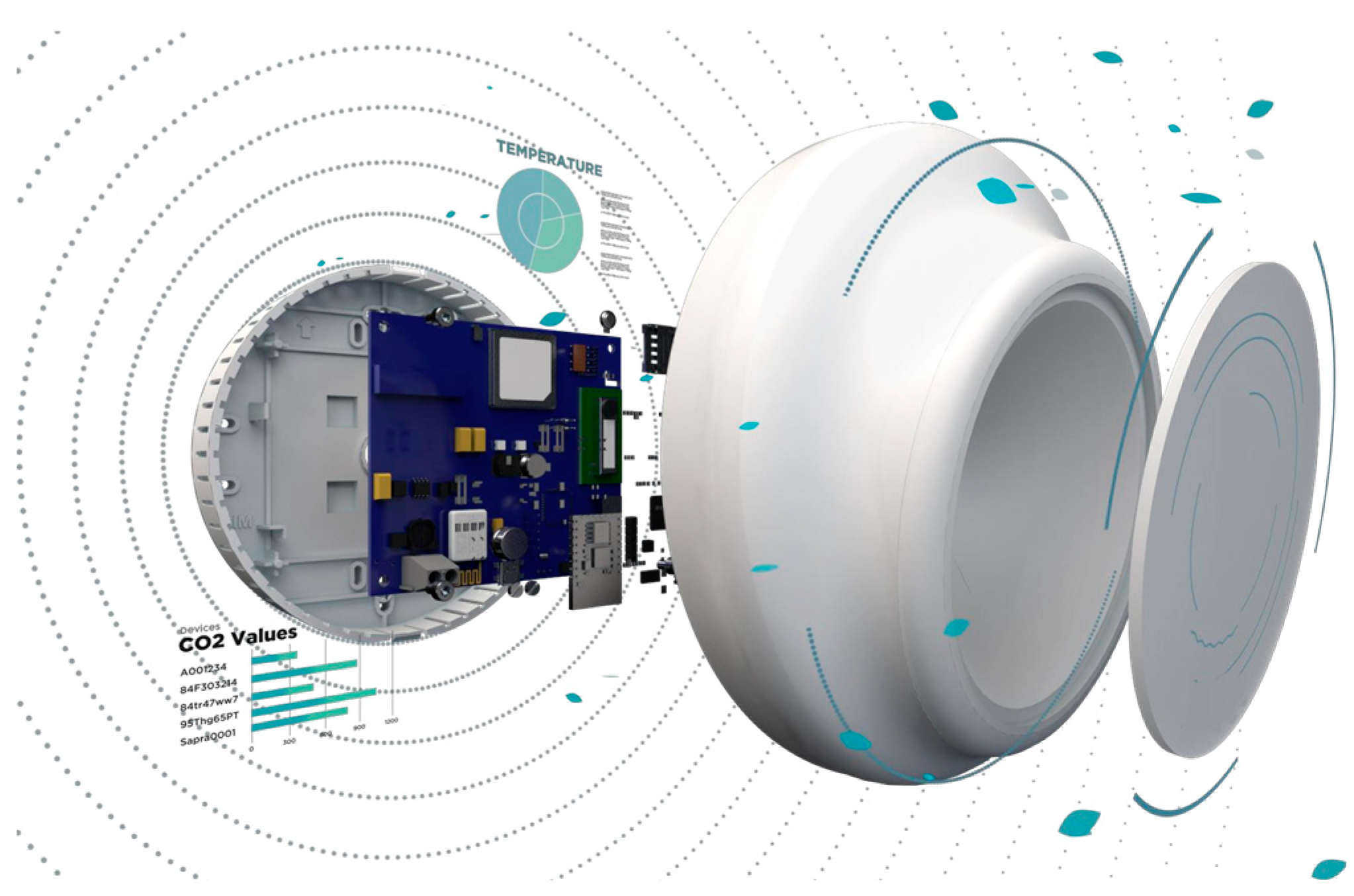

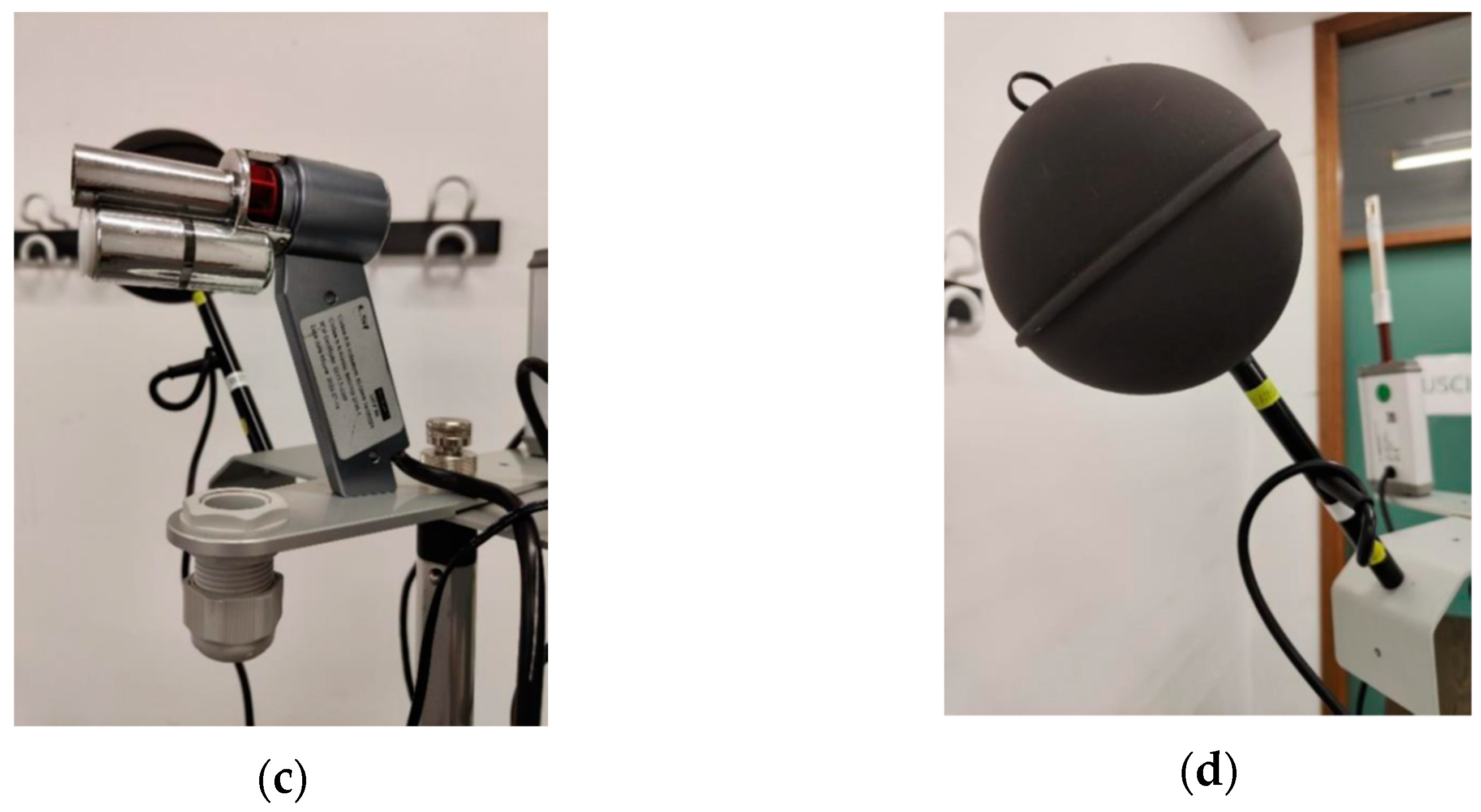
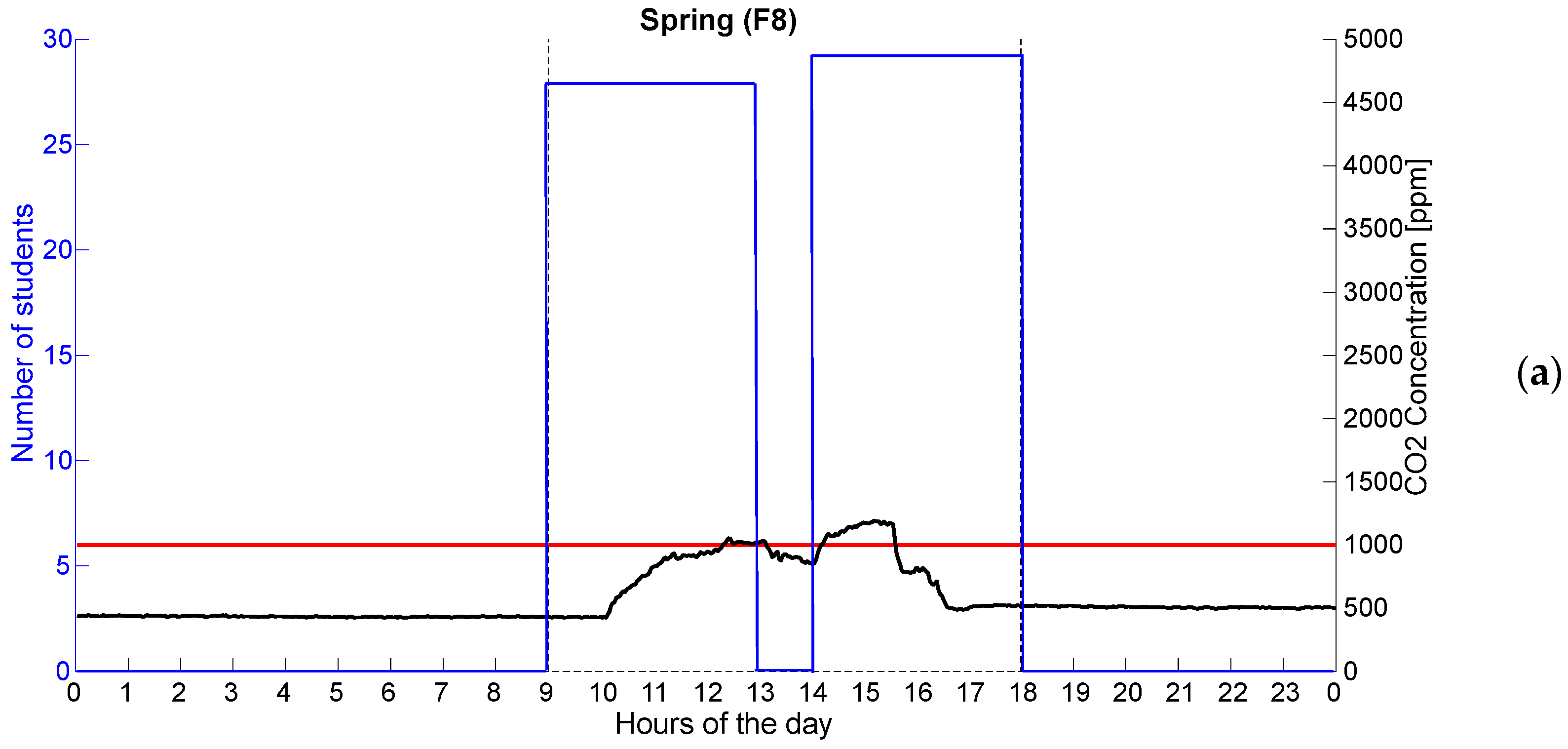
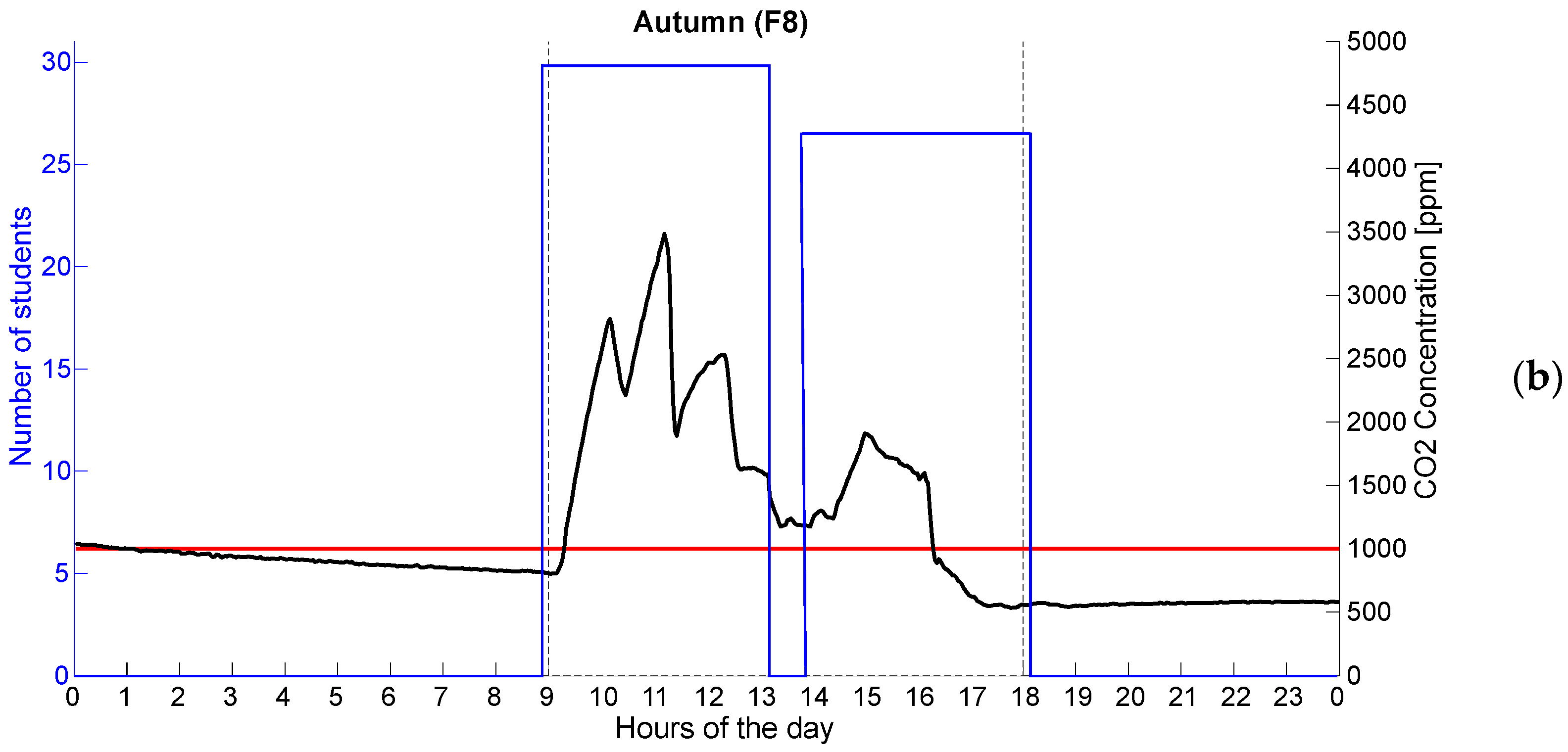
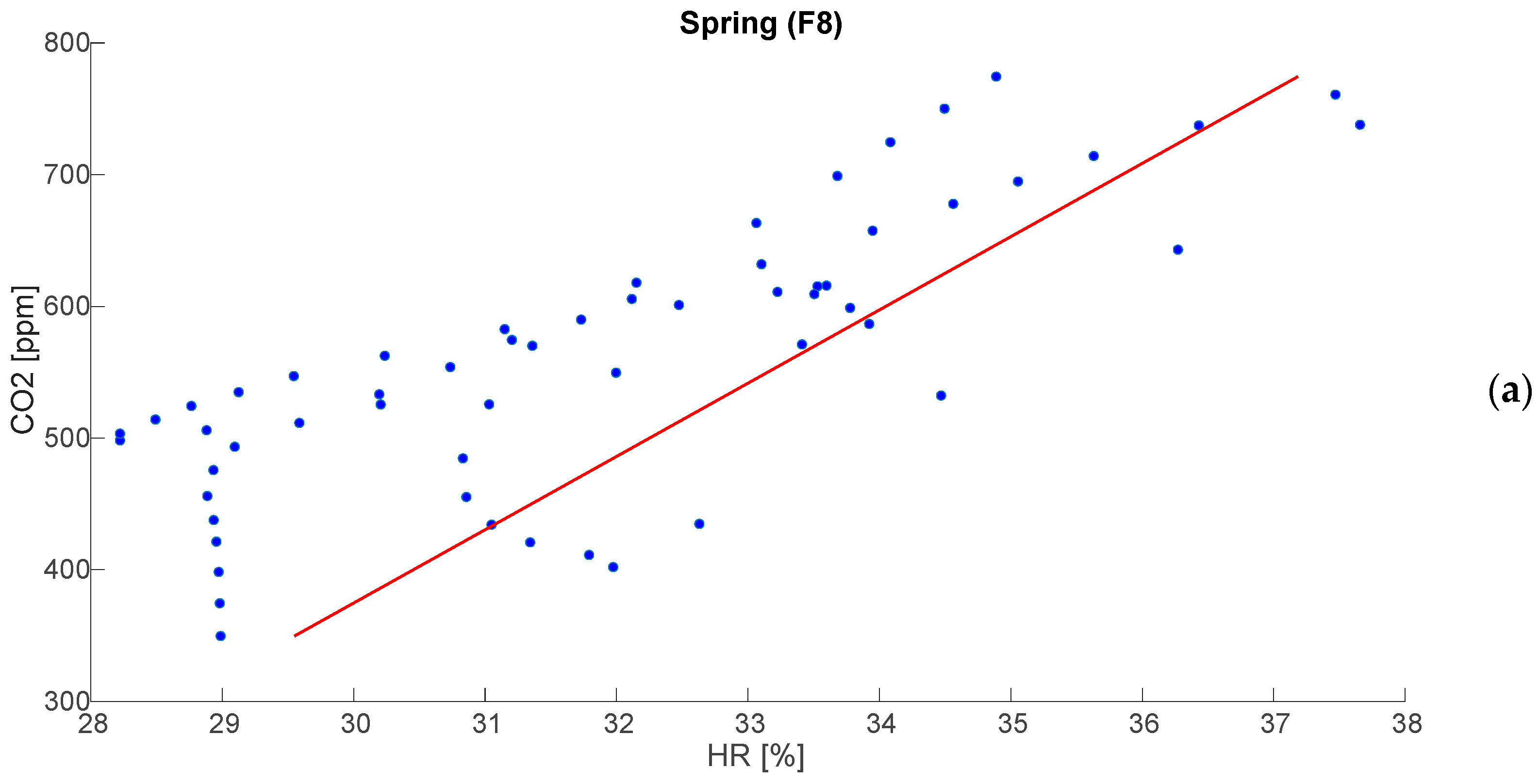

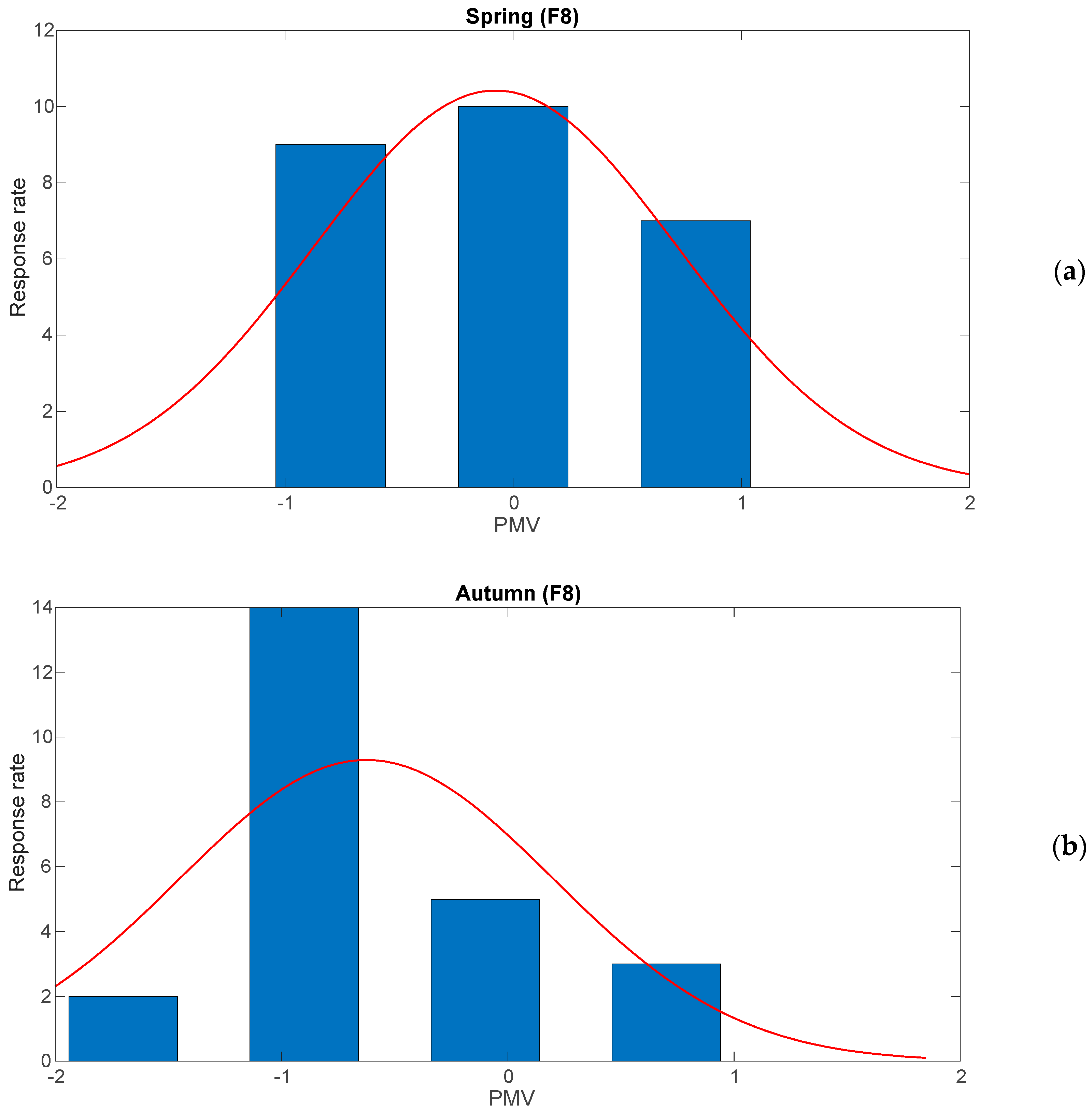
| Variable | Measurement Range | Accuracy | Repeatability | Response Time |
|---|---|---|---|---|
| CO2 | 0–40,000 ppm | ±(40 ppm + 5% reading error) | ±10 ppm | 60 s |
| RH | 0–100%RH | ±9%RH | ±0.4%RH | 90 s |
| T | −10–60 °C | ±1.5 °C | ±0.4 °C | 120 s |
| Sensor | Operative Range | Accuracy |
|---|---|---|
| Hot-wire anemometer | 0–50 m/s | ±0.05 m/s |
| Globe thermometer | −50–100 °C | ±0.17 °C |
| Psychrometer | −50–150 °C | ±0.13 °C |
| 40–100%RH | ±2%RH |
| Season | Avg. Occupancy | Max Occupancy | Gender (%Male/%Female) | Avg. Height (m) | Avg. Body Mass (kg) | Avg Age (y.o.) | |
|---|---|---|---|---|---|---|---|
| F8 | Spring | 27 | 30 | 70/30 | 174 ± 7 | 71 ± 12 | 22 ± 3 |
| Autumn | 26 | 30 | 70/30 | 174 ± 7 | 71 ± 12 | 22 ± 2 | |
| F9 | Spring | 23 | 27 | 75/25 | 173 ± 7 | 72 ± 10 | 22 ± 2 |
| Autumn | 23 | 28 | 77/23 | 172 ± 6 | 73 ± 10 | 22 ± 2 | |
| B1 | Spring | 29 | 30 | 65/35 | 175 ± 7 | 68 ± 11 | 25 ± 1 |
| Autumn | 28 | 30 | 64/36 | 176 ± 8 | 71 ± 11 | 25 ± 2 |
| PMV | Thermal Sensation |
|---|---|
| +3 | Very warm |
| +2 | Warm |
| +1 | Slightly warm |
| 0 | Neutral |
| −1 | Slightly cold |
| −2 | Cold |
| −3 | Very cold |
| F8 | F9 | B1 | ||||||||
|---|---|---|---|---|---|---|---|---|---|---|
| Mean | Max | Min | Mean | Max | Min | Mean | Max | Min | ||
| SPRING | T (°C) | 23.5 * (0.8) | 24.6 (1.3) | 22.6 (1.1) | 23.9 * (0.9) | 27.5 (4.0) | 22.4 (1.1) | 24.5 * (0.7) | 25.6 (0.9) | 23.4 (0.6) |
| RH (%) | 36.5 * (2.1) | 39.4 (2.7) | 32.7 (3.7) | 32.7 * (1.8) | 37.2 (2.6) | 27.4 (3.7) | 34.1 * (3.0) | 38.1 (3.8) | 30.3 (4.3) | |
| CO2 (ppm) | 492.0 * (62.4) | 729.8 (280.1) | 422.71 (33.8) | 503.0 * (36.3) | 953.4 (286.7) | 419.2 (12.6) | 547.4 * (84.6) | 934.6 (200.1) | 425.5 (32.0) | |
| AUTUMN | T (°C) | 21.0 * (1.1) | 24.0 (1.0) | 19.1 (1.5) | 21.5 * (0.9) | 23.5 (0.5) | 20.4 (1.0) | 22.9 * (1.3) | 24.5 (2.1) | 20.9 (2.5) |
| RH (%) | 51.6 * (5.3) | 55.6 (6.5) | 47.1 (6.6) | 50.0 * (4.0) | 51.8 (4.8) | 47.0 (4.4) | 49.4 * (3.9) | 54.2 (4.2) | 46.0 (4.7) | |
| CO2 (ppm) | 1034.0 * (153.9) | 2324.2 (524.0) | 457.2 (51.7) | 664.4 * (92.1) | 1419.6 (224.5) | 475.8 (84.5) | 702.8 * (92.5) | 1399.4 (91.9) | 457.0 (22.1) | |
| r-Value | |||||
|---|---|---|---|---|---|
| Season | Mean | STD | Min | Max | |
| F8 | Spring | 0.84 | 0.03 | 0.78 | 0.89 |
| Autumn | 0.90 | 0.04 | 0.85 | 0.95 | |
| F9 | Spring | 0.85 | 0.02 | 0.80 | 0.88 |
| Autumn | 0.91 | 0.03 | 0.87 | 0.94 | |
| B1 | Spring | 0.83 | 0.04 | 0.76 | 0.88 |
| Autumn | 0.89 | 0.05 | 0.83 | 0.93 | |
Disclaimer/Publisher’s Note: The statements, opinions and data contained in all publications are solely those of the individual author(s) and contributor(s) and not of MDPI and/or the editor(s). MDPI and/or the editor(s) disclaim responsibility for any injury to people or property resulting from any ideas, methods, instructions or products referred to in the content. |
© 2025 by the authors. Licensee MDPI, Basel, Switzerland. This article is an open access article distributed under the terms and conditions of the Creative Commons Attribution (CC BY) license (https://creativecommons.org/licenses/by/4.0/).
Share and Cite
Fedele, A.; Colantoni, A.; Calabrò, G.; Scungio, M.; Rossi, S.; Taborri, J. Measuring CO2 Concentration and Thermal Comfort in Italian University Classrooms: A Seasonal Analysis. Sensors 2025, 25, 1970. https://doi.org/10.3390/s25071970
Fedele A, Colantoni A, Calabrò G, Scungio M, Rossi S, Taborri J. Measuring CO2 Concentration and Thermal Comfort in Italian University Classrooms: A Seasonal Analysis. Sensors. 2025; 25(7):1970. https://doi.org/10.3390/s25071970
Chicago/Turabian StyleFedele, Alessia, Andrea Colantoni, Giuseppe Calabrò, Mauro Scungio, Stefano Rossi, and Juri Taborri. 2025. "Measuring CO2 Concentration and Thermal Comfort in Italian University Classrooms: A Seasonal Analysis" Sensors 25, no. 7: 1970. https://doi.org/10.3390/s25071970
APA StyleFedele, A., Colantoni, A., Calabrò, G., Scungio, M., Rossi, S., & Taborri, J. (2025). Measuring CO2 Concentration and Thermal Comfort in Italian University Classrooms: A Seasonal Analysis. Sensors, 25(7), 1970. https://doi.org/10.3390/s25071970











